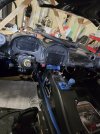You are using an out of date browser. It may not display this or other websites correctly.
You should upgrade or use an alternative browser.
You should upgrade or use an alternative browser.
This is new KOSO gauge that was sent with my slc
- Thread starter Vee
- Start date
Neil
Supporter
You beat me to it!What is a "koso gauge"?
Neil
Supporter
Ah, so... it isn't a koso gauge, it is a Koso gauge.
What is a "koso gauge"?
Nice upgrade to the prior offering. I like it. I wish this was around when I ordered mine.

Sometimes one capital letter does make a big diff!Ah, so... it isn't a koso gauge, it is a Koso gauge.
Neil
Supporter
A long, long time ago I read a very good book on "Human Factors Engineering". I think it's called something else now, but it addressed how to present information to a human in a way that is unambiguous, easily readable, and quickly assimilated. The main points having to do with aircraft instruments, indicators, and switches.
One important point was the preference for round gauges with 270 degree sweep scales. This type of instrument could be read in a fraction of a second, not by reading the dial scale, but by noting the angular position of the indicator needle (pointer). Linear scales are not easy to read; I once owned a car that had a speedometer that was a long horizontal line, increasing speed pushed the line further to the right. I hated that thing.
It seems that modern instrument makers are now attempting to squeeze too much information into a very small space and the lessons learned in the past are now forgotten. I am not a fan of digital displays as the primary instrumentation.
One important point was the preference for round gauges with 270 degree sweep scales. This type of instrument could be read in a fraction of a second, not by reading the dial scale, but by noting the angular position of the indicator needle (pointer). Linear scales are not easy to read; I once owned a car that had a speedometer that was a long horizontal line, increasing speed pushed the line further to the right. I hated that thing.
It seems that modern instrument makers are now attempting to squeeze too much information into a very small space and the lessons learned in the past are now forgotten. I am not a fan of digital displays as the primary instrumentation.
A long, long time ago I read a very good book on "Human Factors Engineering". I think it's called something else now, but it addressed how to present information to a human in a way that is unambiguous, easily readable, and quickly assimilated. The main points having to do with aircraft instruments, indicators, and switches.
One important point was the preference for round gauges with 270 degree sweep scales. This type of instrument could be read in a fraction of a second, not by reading the dial scale, but by noting the angular position of the indicator needle (pointer). Linear scales are not easy to read; I once owned a car that had a speedometer that was a long horizontal line, increasing speed pushed the line further to the right. I hated that thing.
It seems that modern instrument makers are now attempting to squeeze too much information into a very small space and the lessons learned in the past are now forgotten. I am not a fan of digital displays as the primary instrumentation.
"I once owned a car that had a speedometer that was a long horizontal line, increasing speed pushed the line further to the right. I hated that thing."
Amen, brother!
Digital dashboard clocks are another PITB. 'Takes the better part of a week to 'set' the darned things IF you have a degree from M.I.T.
Gimme the good ole manual pull out/twist/push-back-in 'single knob' control system! You're done in about 10 or 15 seconds MAX on your slowest day.
Neil
Supporter
Add to that, radios that have buttons and menus, sub menus and sub, sub menus. I prefer the two round know ones- on/off volume & tune. I once rented a Cadillac out of the Pittsburgh airport and it took until Morgantown to figure out how to turn on the air conditioner. Automotive controls are now in the hands of digital weenies!"I once owned a car that had a speedometer that was a long horizontal line, increasing speed pushed the line further to the right. I hated that thing."
Amen, brother!
Digital dashboard clocks are another PITB. 'Takes the better part of a week to 'set' the darned things IF you have a degree from M.I.T.
Gimme the good ole manual pull out/twist/push-back-in 'single knob' control system! You're done in about 10 or 15 seconds MAX on your slowest day.
Similar threads
- Replies
- 1
- Views
- 264
- Replies
- 4
- Views
- 457
- Replies
- 0
- Views
- 465


